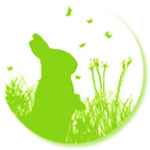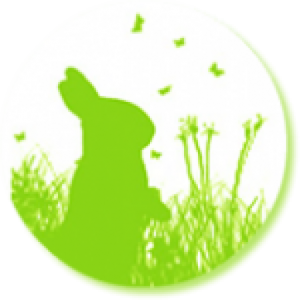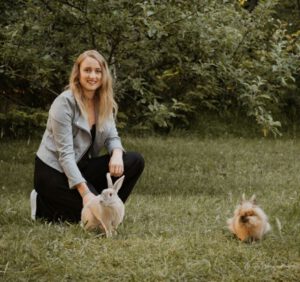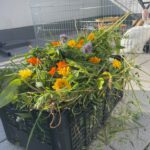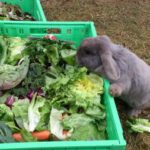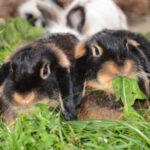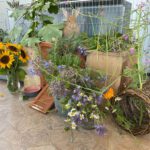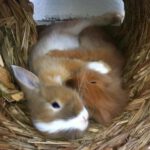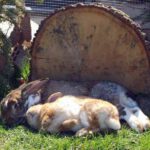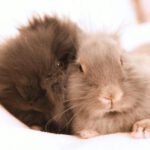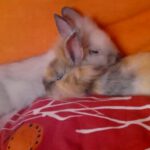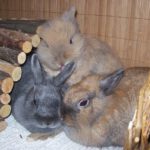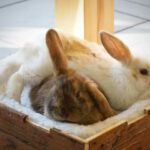Frequently, owners report that their rabbits „suddenly lay dead in the enclosure.“ These deaths are usually preceded by minor signs of illness (quieter behavior, withdrawal, poor or no food intake, increased drinking, etc.) and could have been avoided with timely treatment and examination.
Rabbits require regular care to stay healthy and to detect abnormalities/ signs of illness early. Owners who integrate their rabbits freely into their homes or daily lives, close to humans, often notice abnormalities more quickly than those who only feed, clean, and rarely observe or interact with their animals.
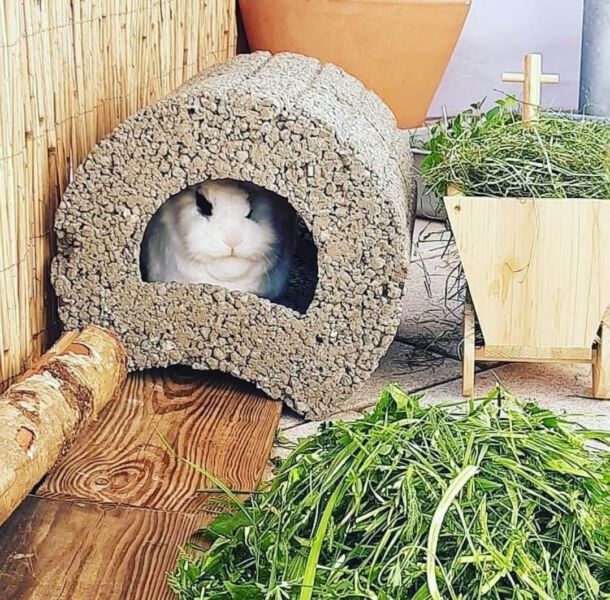
Contents
- Daily Quick Check-up
- Weekly Health Check-up (Rabbit Inspection)
- Weight Control
- Nail Care for Rabbits
- Fur Care and Molt
- Skin Inspection
- Undersides of the Paws
- Chewing Behavior
- Bathing, Adhesions/Feces/Urine in the Anogenital Area
- Cleaning Scent/Inguinal Glands
- Palpation
- Tooth Checks
- To palpate the jaw
- Eye Examination
- Nose Check
- Mucous membranes: eye, nose, or mouth
- Ear Check
Daily Quick Check-up
Once or, preferably, twice a day, rabbits should be observed deliberately, for example, during feeding. For meat rabbits, it is now even required that they be checked for their health at least twice a day. We recommend following this check for pet rabbits as well, by offering a treat or food twice a day. This helps determine if the rabbits are refusing food. Additionally, observe in the morning and evening whether they move and are active normally. Check their feces and urine as well:
Eating behavior (are all rabbits eating normally, do they come for feeding as usual?) Behavior (do all rabbits behave as usual? Changes are usually signs of illness), is one rabbit being bullied (signs of illness), or is one aggressive (pain)? Feces (soft, diarrhea, small and hard…?), urination, and urine (if possible) – Urine and droppings analysis.
Weekly Health Check-up (Rabbit Inspection)
Especially when the animals do not live intensively with the owner, it makes sense to check all rabbits thoroughly weekly, or at least twice a month, and take the time for it. All the points listed below should be checked, especially a thorough examination of the underside (anal area!), claw care, weight check, and a general health check. For the general health check, all signs of illness should be ruled out: Learn to recognize and assess signs of illness If it is known that an animal is prone to a specific illness, it should, of course, be checked more frequently for that issue.
Weight Control
Even if the animals appear to be healthy, it is advisable to weigh them weekly or at least once or twice a month and record the weight in a log. This allows for comparison with the normal weight in case of illnesses, as many diseases are first noticeable through weight loss. Note that weight gain in the fall (winter coat) and weight loss in the spring is quite normal. Weighing should always be done at the same time (e.g., before the evening feeding) because the food in the digestive tract accounts for about 80g.
With good observation and close contact with the rabbits, weight control is not necessarily needed (e.g., free-range indoor housing).
Weight gains require adjustments to the diet unless the rabbit is underweight or in a growth phase.
Weight loss should be monitored in the following days by repeated weighing. If it persists, the rabbit should be taken to the veterinarian.
Weighing is relatively easy by placing a grippy surface (carpet, etc.) and a favorite treat on a baby scale, so the rabbit hops on it curiously and stress-free. A baby scale is ideal for this purpose. View/Print the Weight Log.
Nail Care for Rabbits
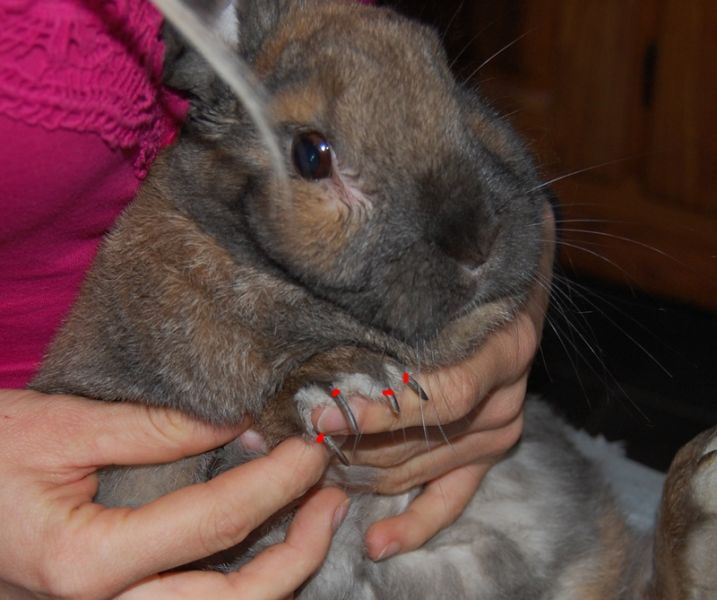
Rabbit nails continuously grow throughout their lives. In the wild, they are naturally worn down by running on rocks and digging, but in domestic settings, rabbits often live on soft or smooth surfaces and/or have limited movement. Therefore, their nails need regular trimming and monitoring.
Overgrown nails can be painful, hinder movement, may tear off (very painful!), or split. They can also curl, twist, and/or grow into the foot. Inadequate nail care represents a severe neglect of the animal.
Nails contain a nerve, and cutting into this nerve should be avoided. A veterinarian or experienced rabbit caregivers can demonstrate the proper way to trim the nails.
Avoiding nail trimming can be achieved by placing some rough stone slabs at central locations and placing sidewalk tiles in the digging box on the floor.
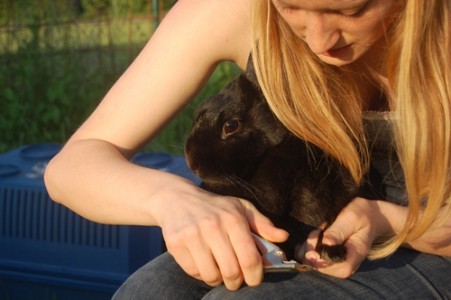
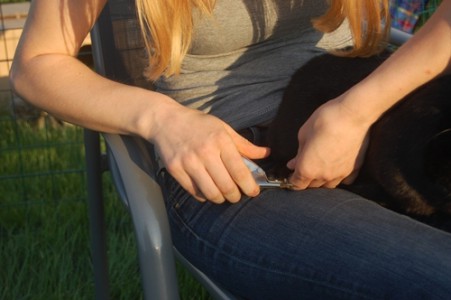
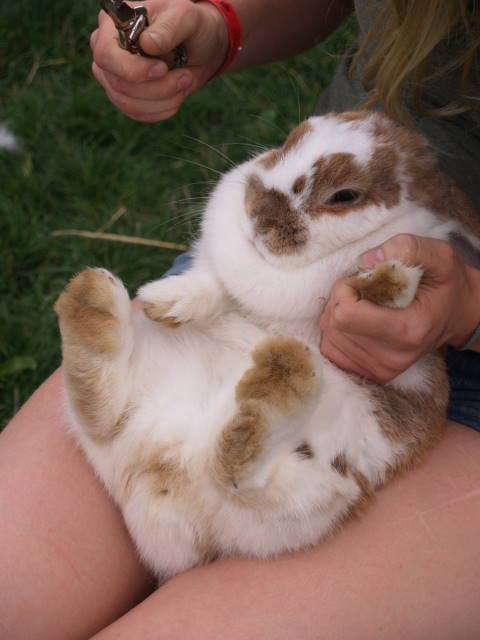
Fur Care and Molt

For healthy and short-haired rabbits, fur care is only necessary during the molt.
A significant molt can manifest in various ways. Depending on the rabbit’s vitality, the molt may go unnoticed, and the fur may remain smooth and glossy.
Some rabbits may develop a very scruffy coat during the molt (1st photo on the right) with many protruding tufts of fur that can be easily plucked or combed out. This can occur in sick, poorly nourished, or elderly rabbits, as well as during periods of high stress (introduction to a new environment, vet visits, heat, etc.) or in rabbits with a predisposition.
In such cases, regularly remove the loosely fitting, protruding hairs by plucking, gently stroking, or combing them out. The ingestion of loose hair can lead to hairballs/blockages, which can be life-threatening. A fine-toothed comb is suitable for this purpose. When removing the protruding hairs, in extreme cases, bare spots with healthy skin may appear, which, unlike scabby, sore, or altered skin areas, are not a cause for concern (2nd photo on the right).
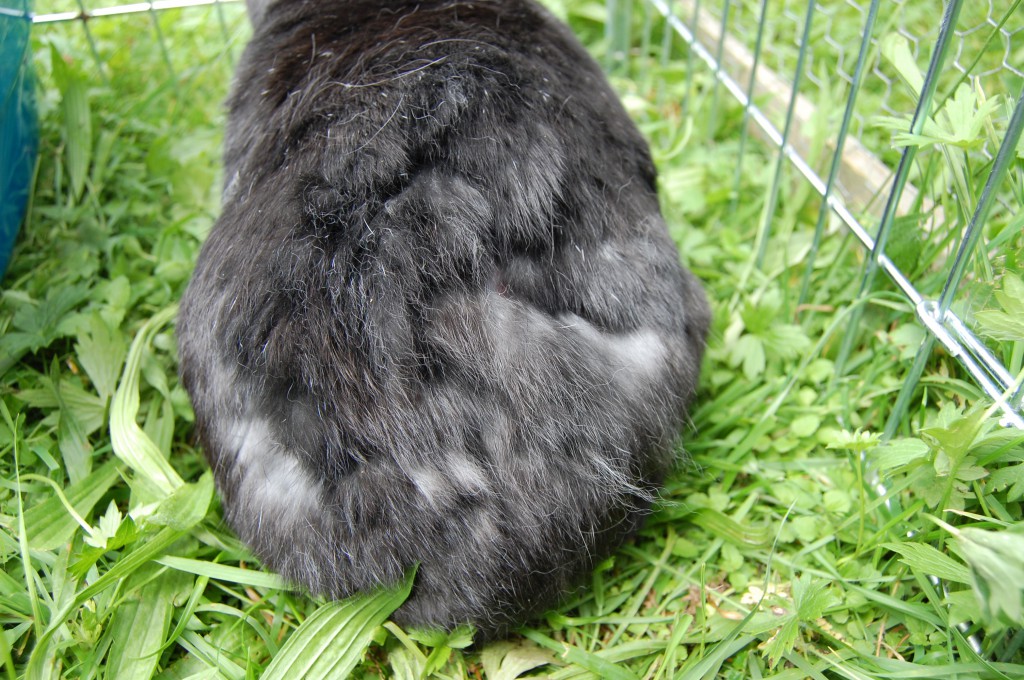
If new hair is already growing in that area, strange fur patterns often result. Bald spots can also occur during false pregnancies when females pluck their fur (during this time, the fur is very loose) and use it as nesting material (4th photo on the right). Additionally, sunflower seeds and other oilseeds, as well as green feed in large quantities, can be fed to support them.
For long-haired rabbits, it is necessary to regularly trim the fur to prevent it from restricting their movement, obstructing their field of vision, or becoming soiled. Any matting must be cut out as it can be painful for the rabbit. Usually, fur care is required at least once a month. When cutting hair and detangling, be careful not to injure the rabbit with scissors.
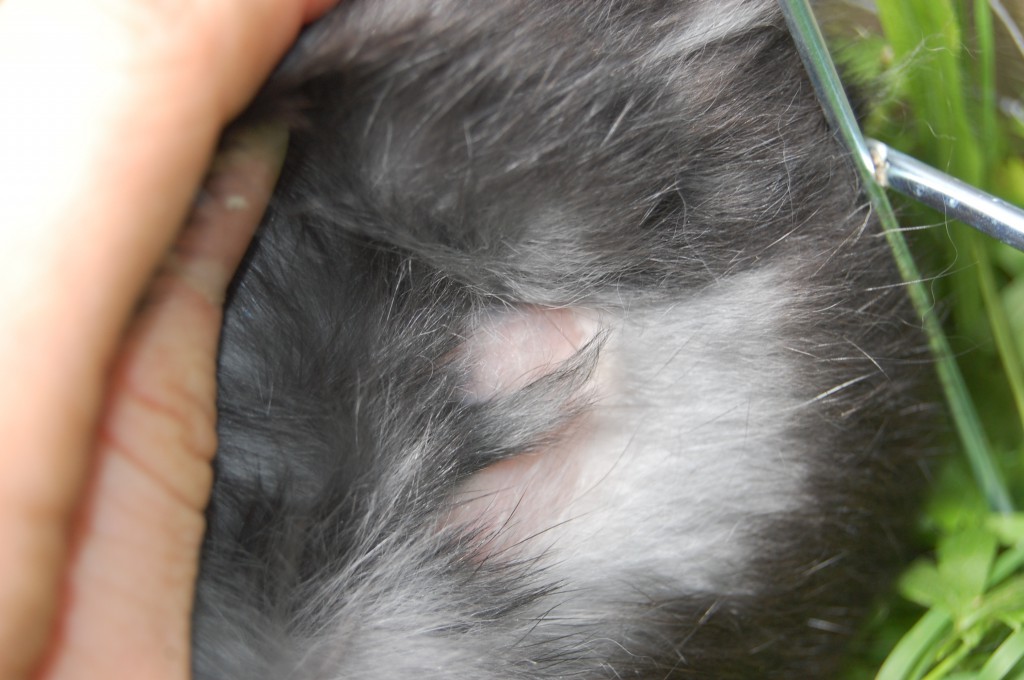
A „slicker brush“ has proven to be quite effective for this purpose. Rabbits usually accept it well and may even enjoy being brushed. Moreover, it effectively removes loose hairs from the fur. If you have real fur monsters, a high-quality clipper is preferable to scissors. It is faster, more pleasant for the rabbits, and the risk of injury is much lower than with scissors.
Especially in the genital area, the fur should be trimmed to prevent soiling. However, it must be ensured that the genital parts are never injured. This fur care is not particularly pleasant for the rabbits but is still urgently necessary.
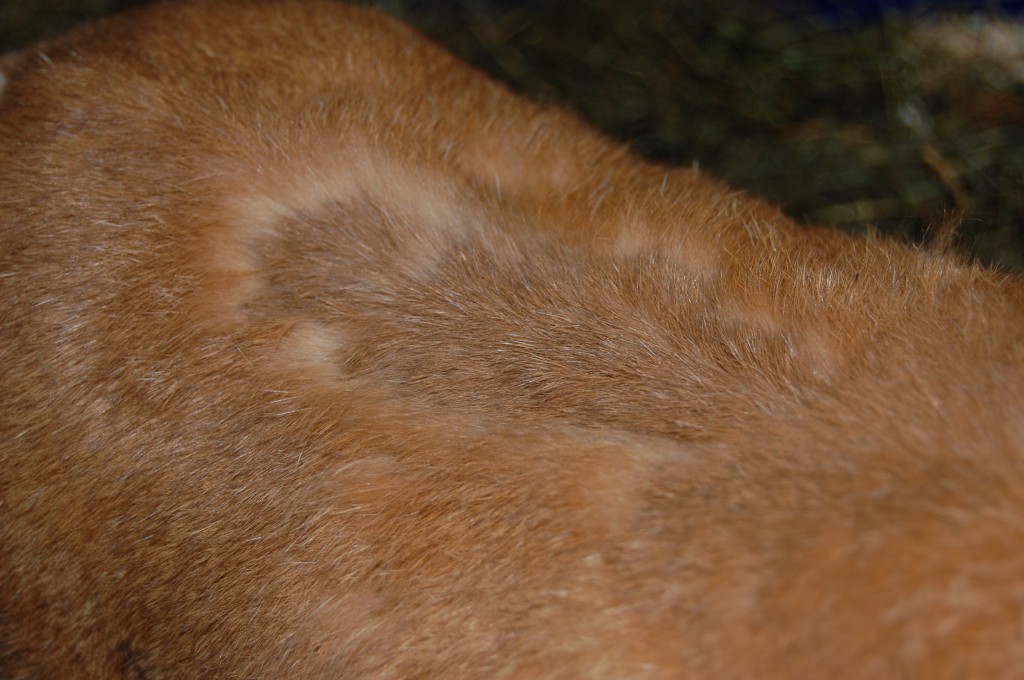
Regular fur care can be done on the ground in the enclosure, which is more relaxing for the rabbits. Cover the head with a cloth or your hand so that the rabbit cannot see anything, then it will remain calm. Most rabbits then move backward, so a hand or an object should be positioned behind the rabbit. Additionally, you can offer their favorite treats and set up a fence around the rabbits while brushing, so it works without the stressful lifting. It is also possible to equip a narrow exit with a brushing edge, so that the rabbits are automatically and stress-free freed from loose fur while passing through. For more extensive fur care procedures, the rabbit can be lifted or placed in a box. During fur care, always check for wounds, abrasions, bald spots, scabs, crusts, scales, or other signs of illness or parasites.
To prevent hairballs, a green-food-rich diet (unlimited green food day and night as the main food) combined with the feeding of well-soaked psyllium husks, linseed cake, or sunflower seeds is recommended during molting.
Skin Inspection
Skin changes occur due to diseases: scales, bumps, swellings, redness, wounds, black spots.
Undersides of the Paws
These should be evenly covered with fur. Any bald patches or scabby, inflamed, or otherwise noticeable areas? See Wounded Paws.
Chewing Behavior
Changes in chewing behavior are an indication of dental problems. If you observe your rabbits at least once a week, you can detect dental issues early if they chew differently. Is chewing slower, one-sided, or does the rabbit drop food from its mouth? Does the rabbit chew on food indefinitely or selectively eat only certain foods (e.g., soft food, while rejecting hay)?
Bathing, Adhesions/Feces/Urine in the Anogenital Area
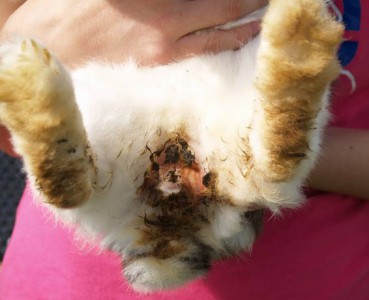
Many illnesses can lead to diarrhea, increased cecal output, or incontinence/soiling. As a result, the genital area can become completely soiled and matted.
Rabbits need regular checks to ensure this area stays clean.
A gentle way to inspect the hindquarters is to look at this area when the rabbit is hopping or when it stretches its hind legs in a relaxed state; this can be done without lifting, stress-free.
Caution: Fly Maggot Danger! In the summer months, rabbits with dirt or wet fur are at an increased risk of flystrike. The cause must be identified and eliminated quickly, the genital area kept very clean, and the rabbit protected from flystrike with temporary indoor housing or flyscreens. The genital area should be examined, possibly cleaned, and checked for fly maggots at least twice a day. Maggots hide especially in the pockets to the right and left of the genital area and at the base of the tail. To protect rabbits at risk of flystrike, spot-on treatments can also be applied; see Flystrike.

If there is soiling, carefully trim the worst with small, non-pointed scissors (Caution! Never injure the genitals!) and place the rabbit with its hindquarters in a bowl (filled with lukewarm water and soap or, even better, golden oil soap). The rabbit should never be bathed all over unless it is truly extensively soiled, which only occurs in severely ill, neglected rabbits. Ensure that the rabbit remains seated with its hindquarters in the bowl so that the crusts can soften (place a towel over its head, hold it firmly, offer food, put it in a small box, etc.). After a short soaking time, the genital area can be washed with a wet cloth, crusts loosened, and dried. After drying, it must wait in a warm, draft-free place until the area is dry again to prevent it from catching a cold. Often, using a hairdryer is also useful. Once the worst crusts are removed, daily cleaning with baby wipes can keep the soiling to a minimum, reducing the need for a more thorough cleaning. We have had very good experiences with these flea combs and plucking brushes for loosening mats in the anogenital area.
In cases of adhesions/incontinence/cecal pellet sticking, a veterinarian must be consulted afterward. Bring a stool sample from three days if available. Not only digestive problems (diarrhea, worms, dental issues, yeast, etc.) and incontinence (bladder diseases, bladder sludge, etc.) can lead to adhesions, but also obesity (the rabbit cannot reach its hind end to consume cecotropes and clean itself), a too energy-rich diet (excess cecotropes), or joint pain (arthritis, etc.) are often causal.
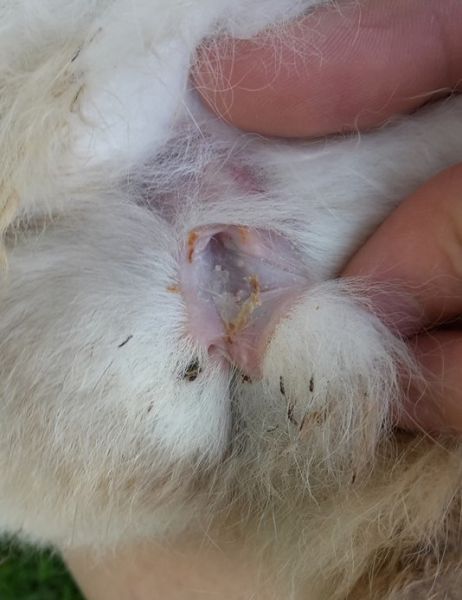
Cleaning Scent/Inguinal Glands
Male and female rabbits have two scent glands (for marking territory) on either side of the genitals. These are two small pockets. Not all rabbits clean these genital pouches, and they can become heavily soiled, especially after bouts of diarrhea or problems with cecotropes. Therefore, they need to be gently cleaned with a moist or oil-soaked cotton swab. The yellowish-white-brownish secretion has an unpleasant odor and crusts in the glands. If suspected, check the genital pouches and clean them if necessary. The genital pouches are also a popular area for flystrike; they are almost always the first place to check!
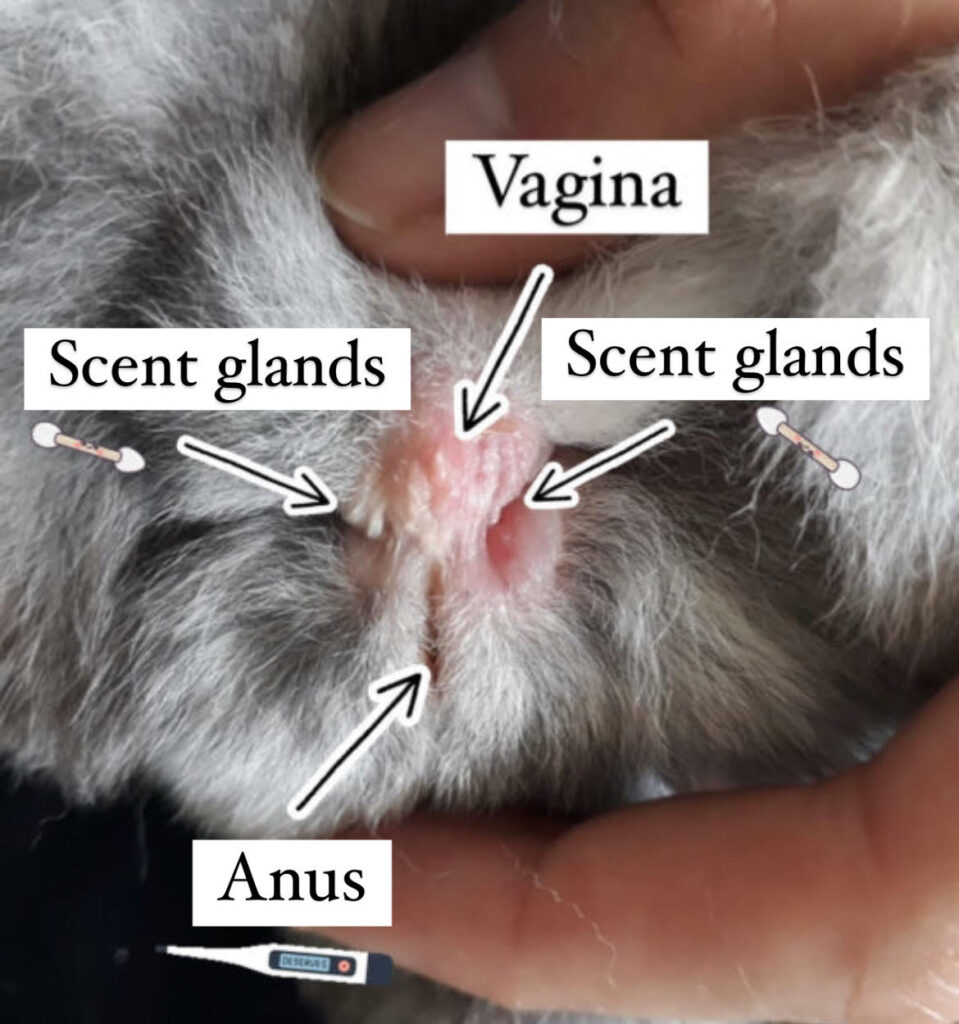
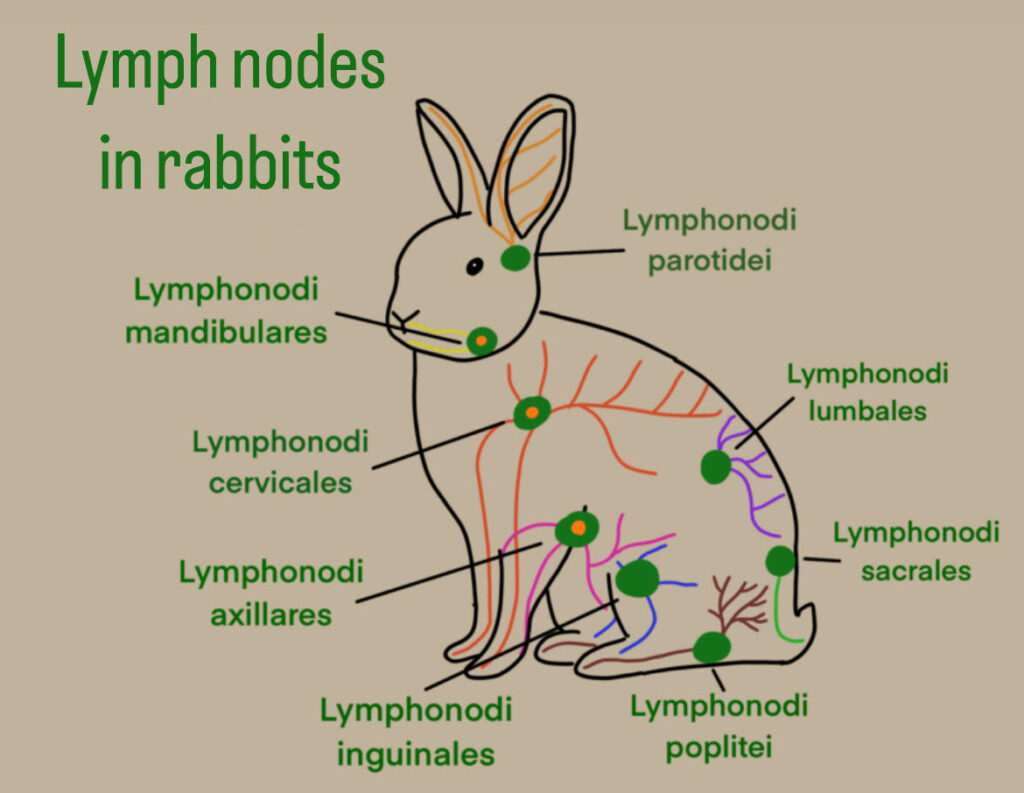
Palpation
Practice makes perfect! Those who frequently palpate rabbits will notice changes. Is there a palpable lump somewhere that wasn’t there before? It could be a lymph node (inflammation, tumor…), an abscess, or a tumor. The earlier you detect such a condition, the better you can treat it!
The graphic on the right helps to learn how to palpate lymph nodes. Most of the time, they are several small, round to oval lymph nodes embedded in fat, making them feel like a knot no larger than a pea. The orange-marked lymph centers in the image are usually, but not always, palpable. In diseases, the nodes are much larger, sometimes up to the size of a plum. The following lymph nodes can be palpated in a healthy rabbit:
- Bilaterally under the jaw, the submandibular lymph nodes (Lymphonodi mandibulares)
- Bilaterally at the shoulder level, the cervical lymph nodes (Lymphonodi cervicales)
- Bilaterally at the beginning of the front leg from the inside, the axillary lymph nodes (Lymphonodi axillares)
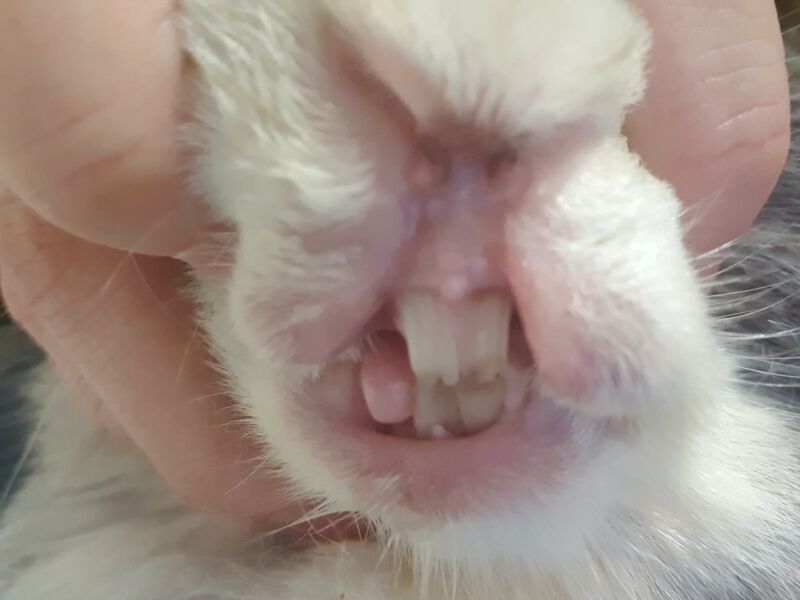
Tooth Checks
When observing rabbits yawning, you can gently check their teeth, possibly supported by taking a photo with your smartphone. Otherwise, it is possible to push aside the lip and inspect the position of the incisors.
In this process, the incisors are examined from the front and from the side (which also provides a good view of the peg teeth).

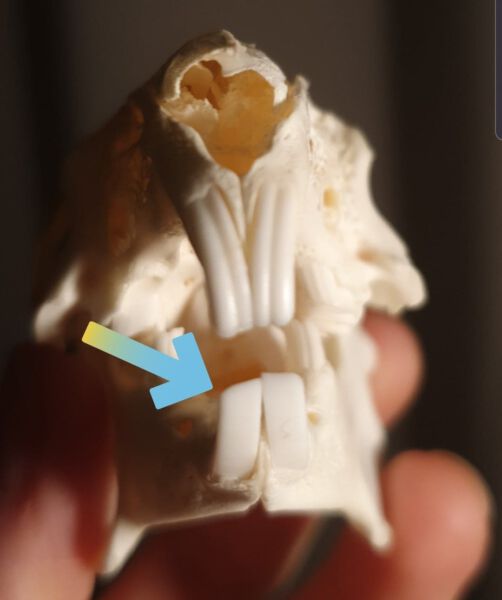
Right: Front view – Good tooth structure, a light-colored tooth, longitudinal grooves, and correct tooth length indicate that the incisors appear to be healthy. However, the cutting surface is not straight/horizontal but asymmetrically worn – this indicates a molar issue on the right side!
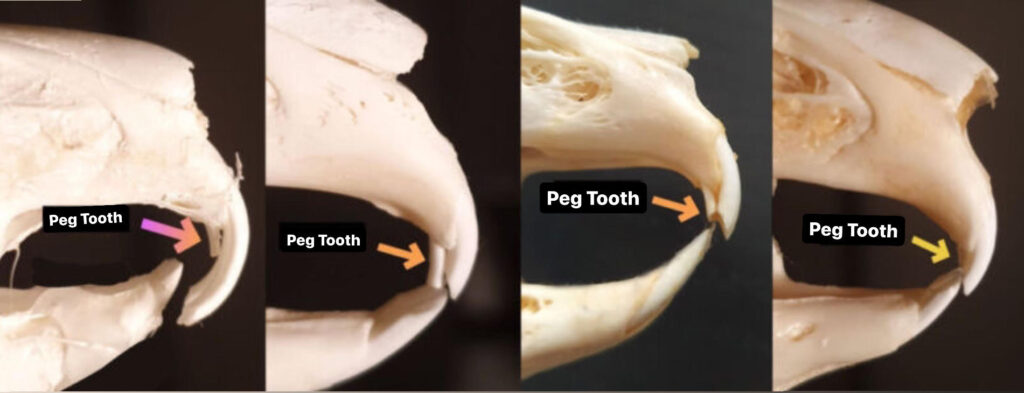
The molars should be checked by the veterinarian with appropriate tools, and this should be done twice a year during the health check/vaccinations with a rabbit-savvy veterinarian, as many diseases go unnoticed.
Even if rabbits drool on their chin, have a runny nose, or eye discharge, these are indications of dental problems. Excessive growth of incisor teeth is also easy to see.
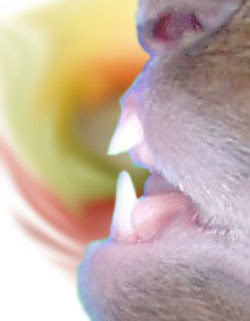
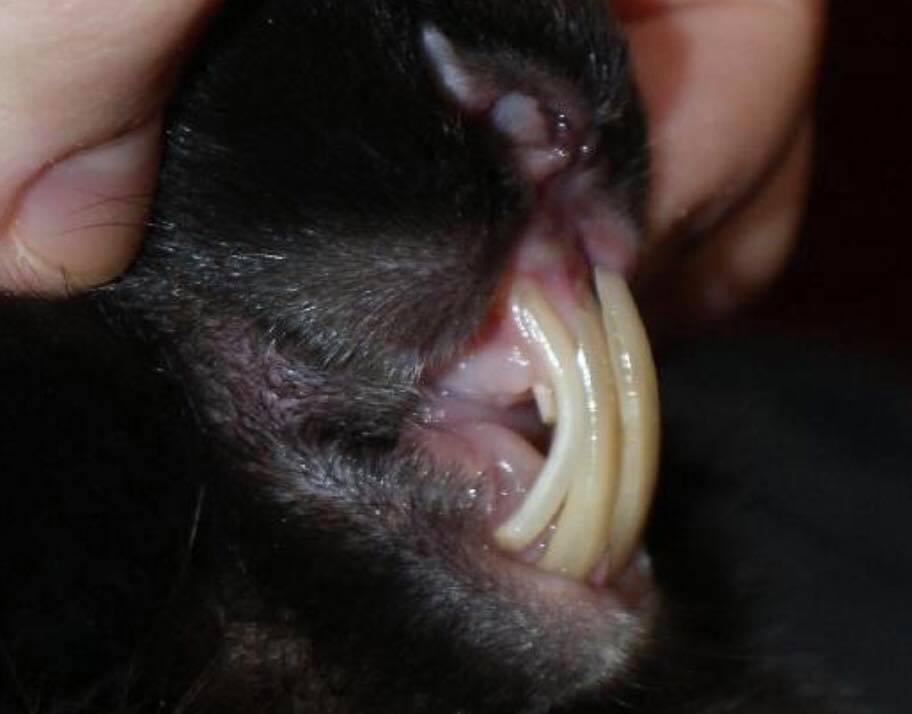

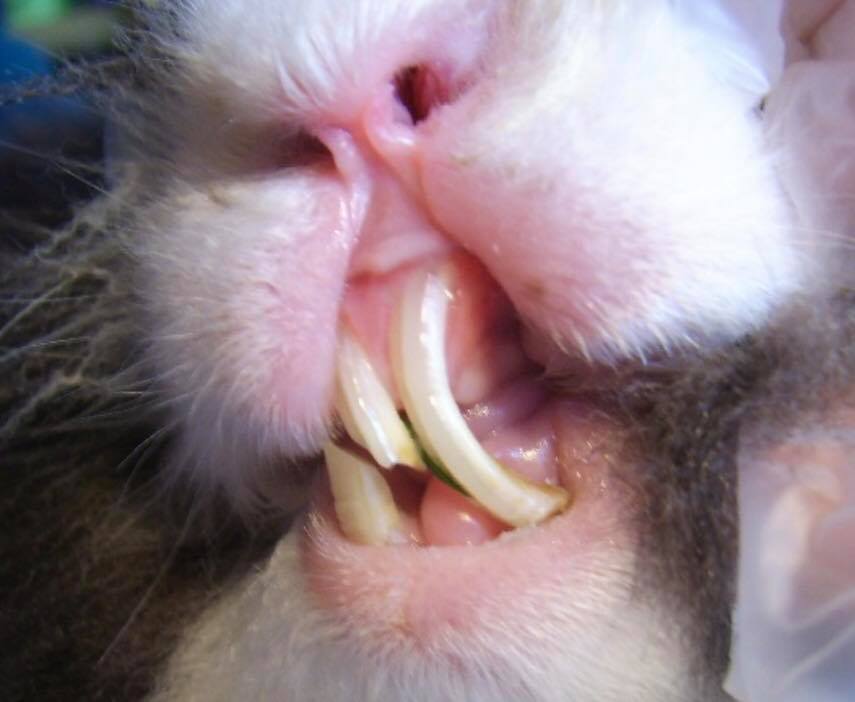

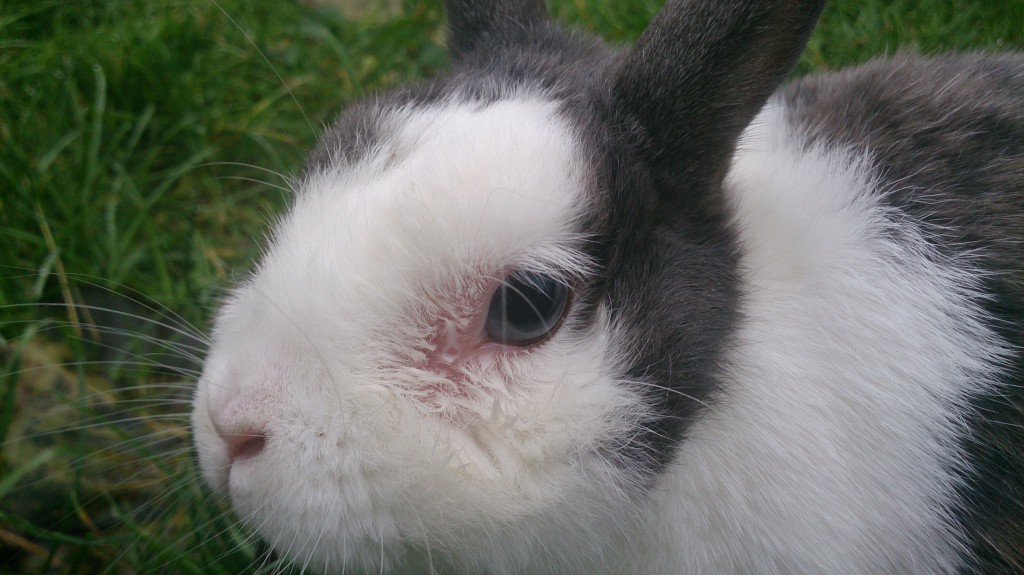
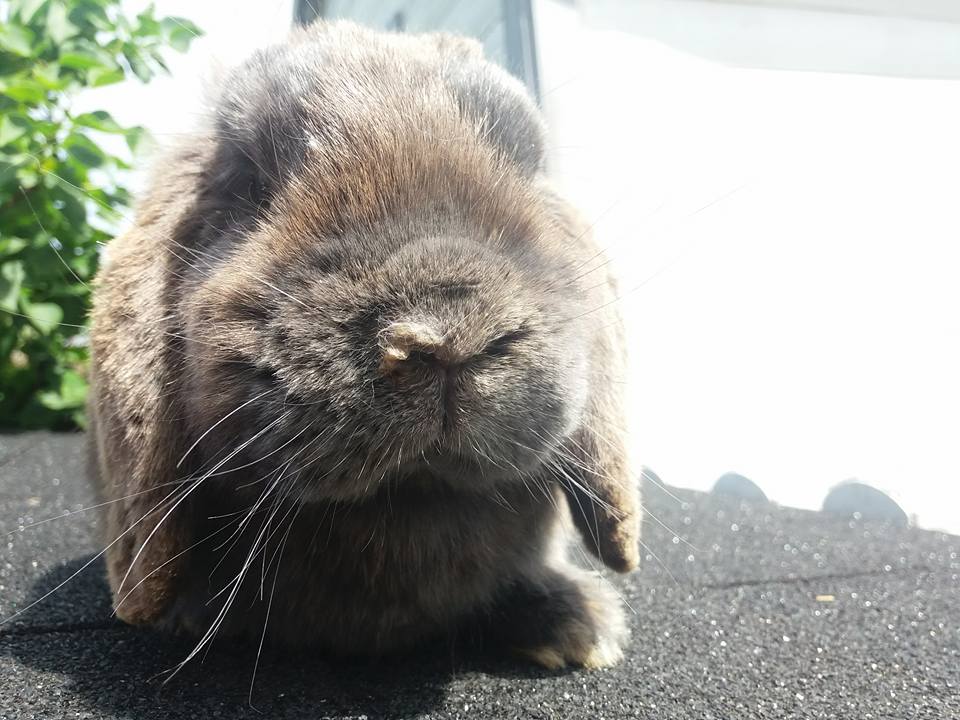
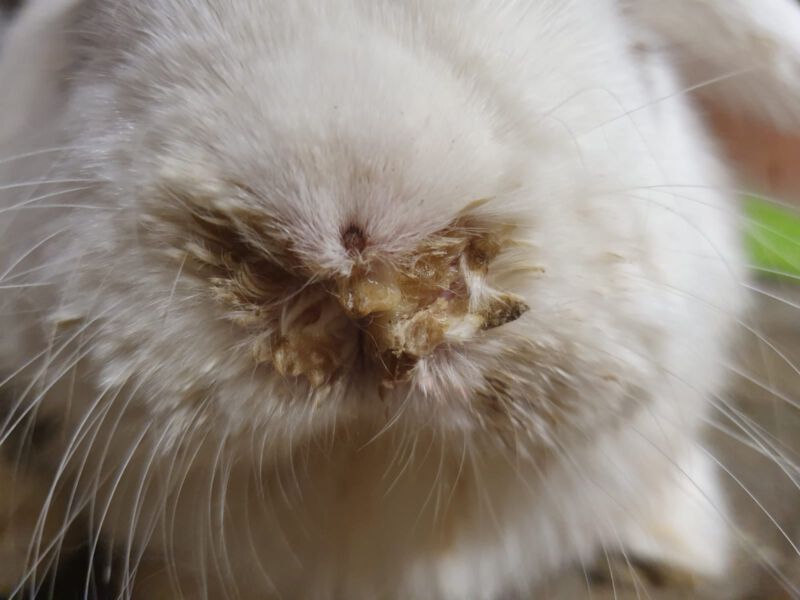
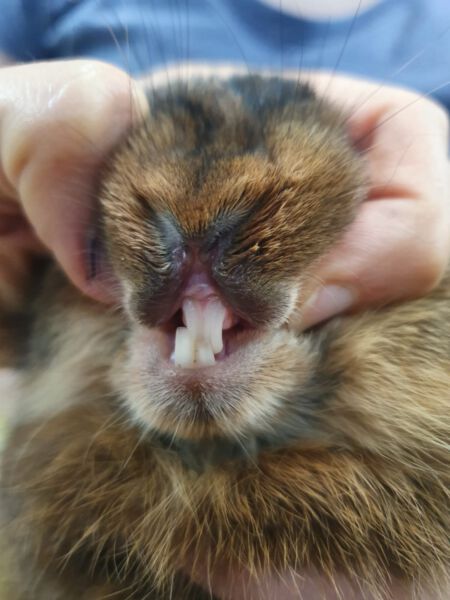
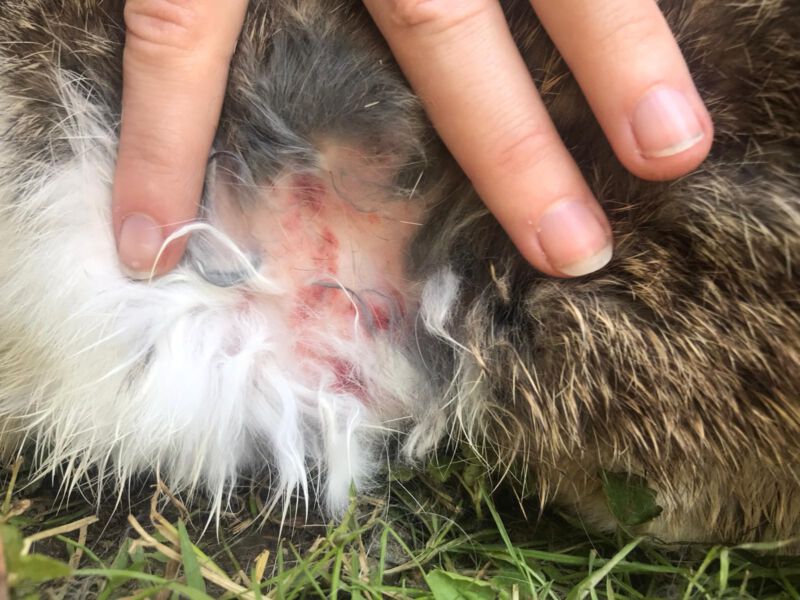
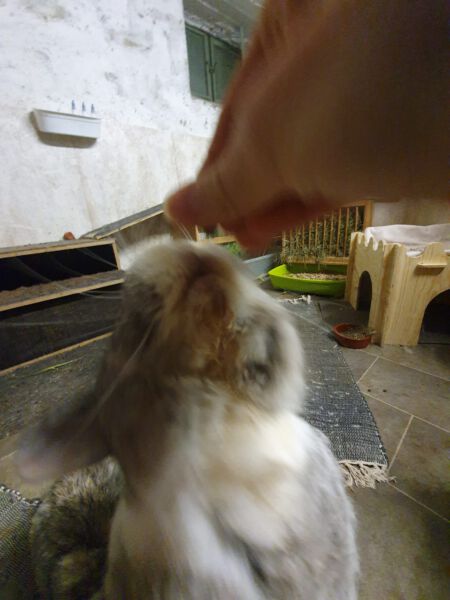
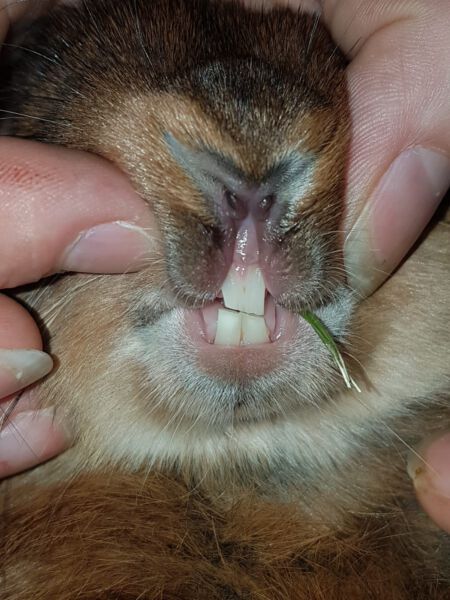
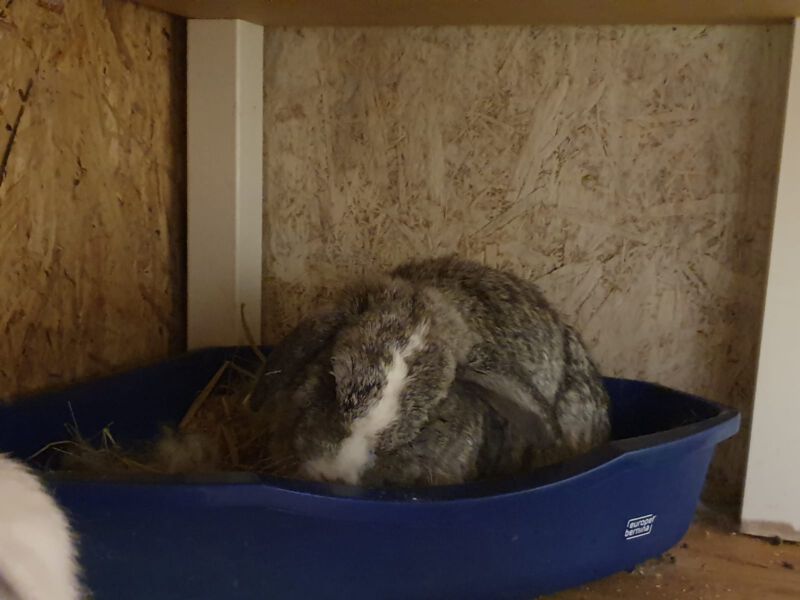
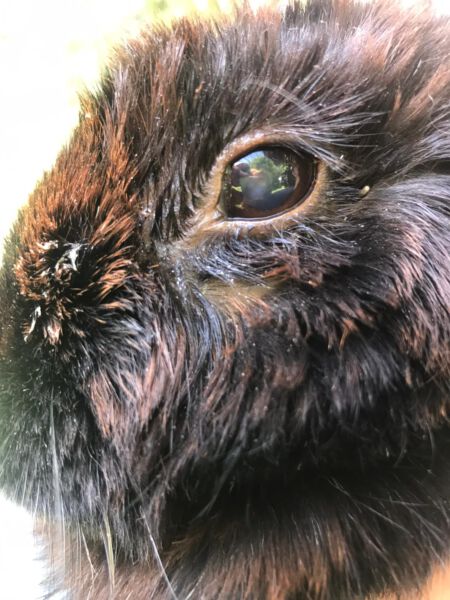
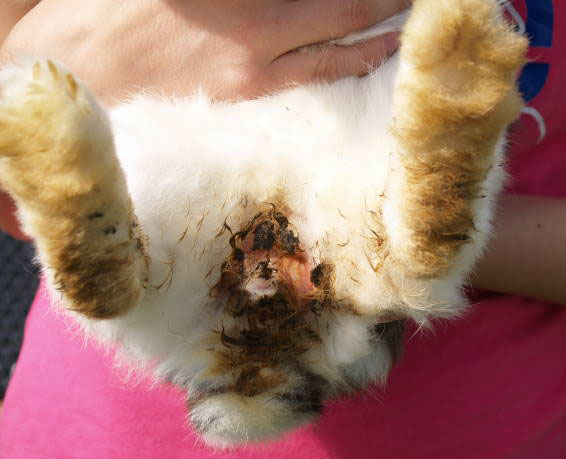
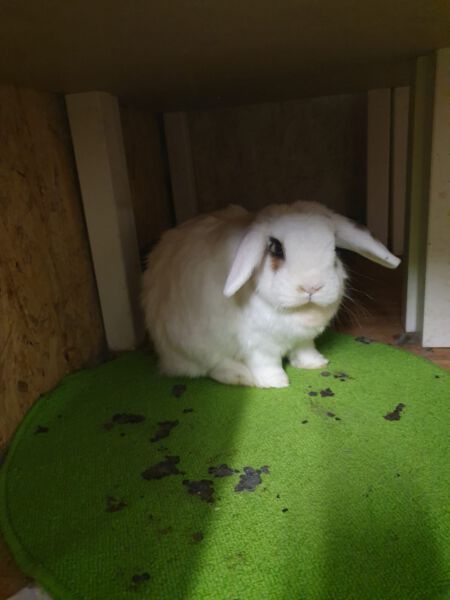
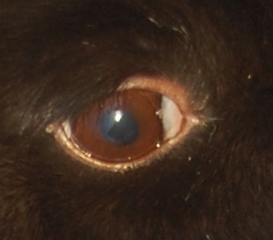
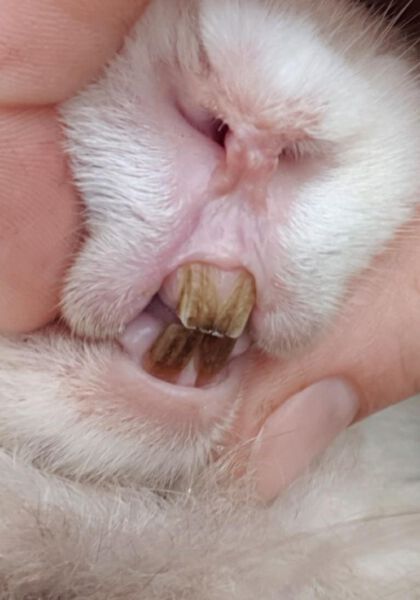
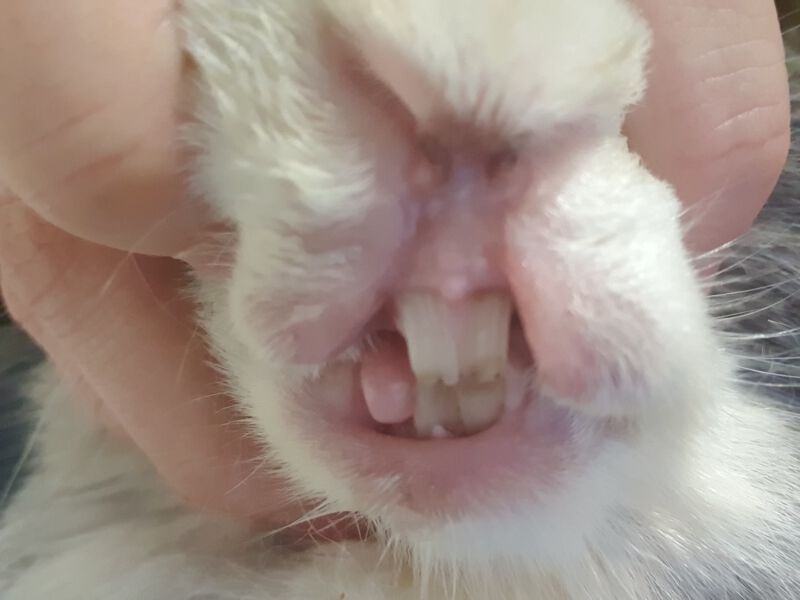
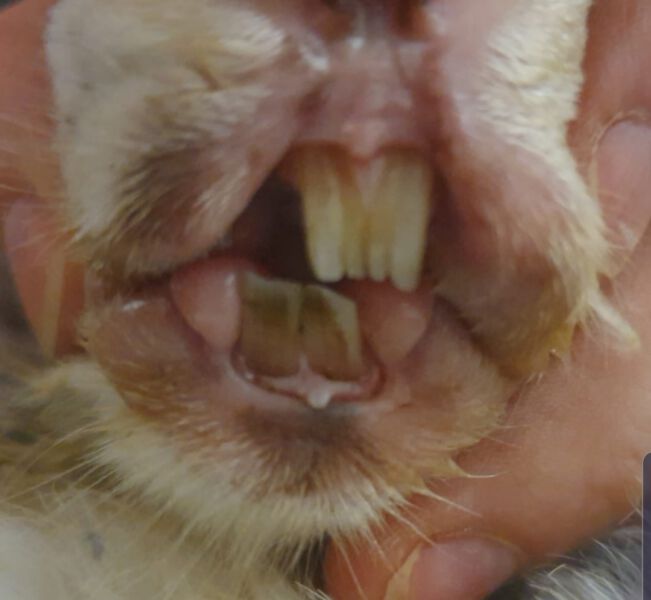
To palpate the jaw
With a practiced touch, you can check whether there are cartilage/thickenings in the jaw (suspected abscess!). For this, you would feel along the jawbone underneath the chin and compare both sides or feel along the upper jaw under the eye up to the nose. The side-by-side comparison helps to identify abnormalities.
Eye Examination
The eye examination is an important part of regular rabbit care. Here are some points to consider:
- Clarity of the eyes: The eyes should be clear, without cloudiness or milky spots.
- Lid opening: Rabbits should normally keep their eyes wide open and not constantly squint.
- Discharge: There should be no excessive tearing or purulent discharge from the eyes.
- Redness/Inflammation: The eyes should not appear red or inflamed.
- Spots: Pay attention to unusual spots or discolorations on the surface of the eyes.
If you notice any abnormalities, this could indicate an eye disease or infection. In such cases, it is advisable to consult a veterinarian for a more detailed examination of the eyes and appropriate measures.
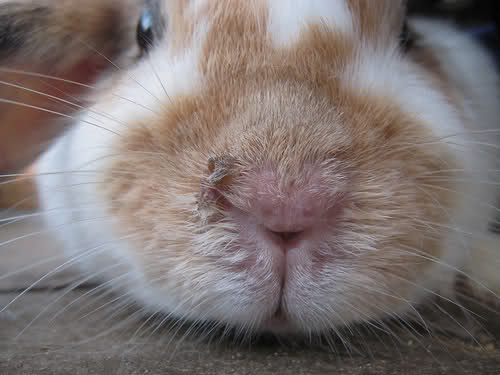
Nose Check
The nose should always be dry, free from scabs and secretions, and the rabbit should not sneeze. Otherwise, there could be a respiratory or dental disease that needs immediate attention.
Mucous membranes: eye, nose, or mouth
What is the condition of the mucous membranes? They tell us a lot about the circulatory state. The mucous membranes are assessed by looking inside the edge of the eye. Is it nice and pink around the eye, or is it inflamed (red) or pale? Alternatively, the mucous membrane can be assessed at the mouth or nose. This helps to evaluate the circulatory state.
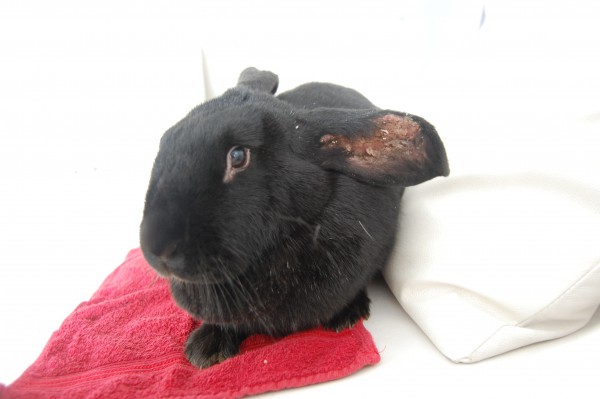
Ear Check
Changes in the skin of the ear (red spots, scabs, etc.) or dirt in the ear canal are signs of illness.
For lop-eared rabbits, it is advisable to perform ear care with ear cleaner weekly or at least monthly. It is also recommended to weekly check the base of the ears (slight bulges? Possibly warm? Sensitivity to touch? Itching?). Head shaking or scratching ears? Crooked mouth? Scanning? You should be familiar with the symptoms!
